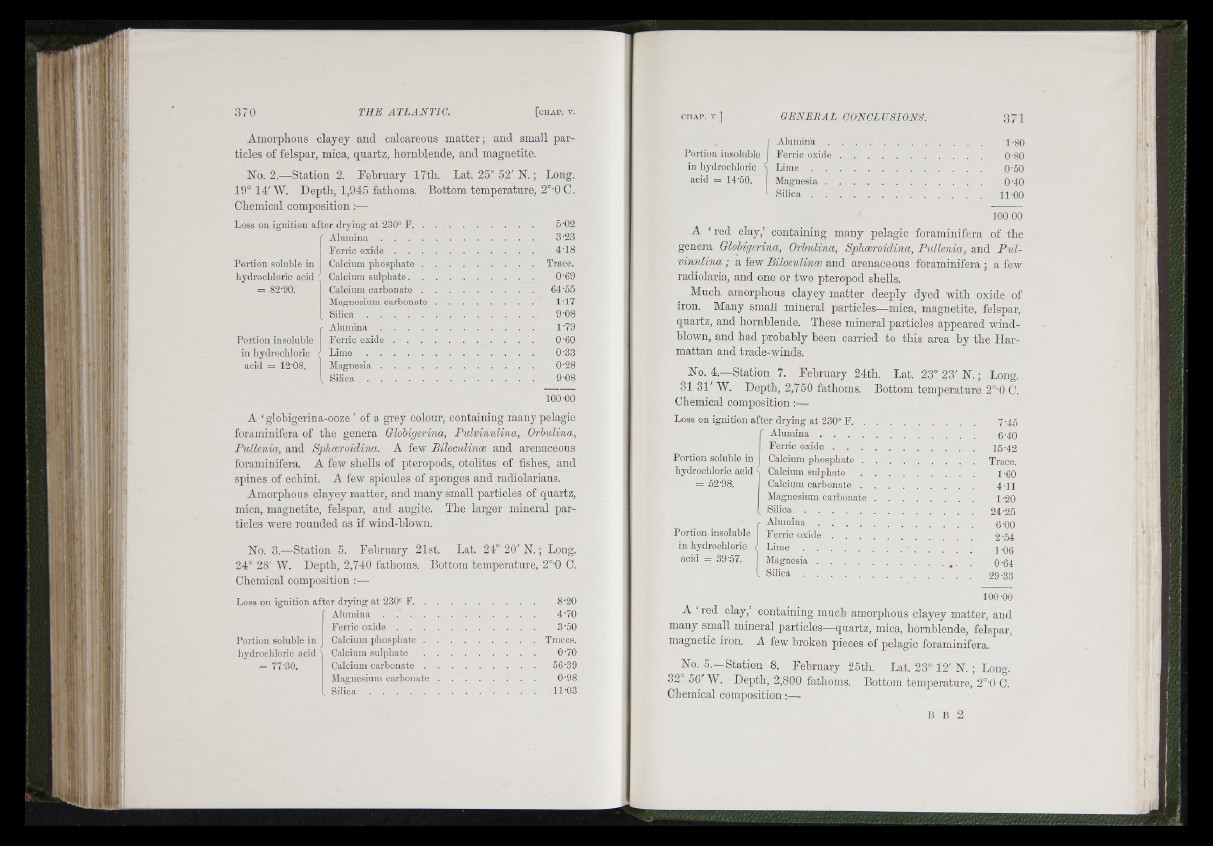
U’l:í
: + : Jil H' '
Amorphous clayey and calcareous matter ; and small particles
of felspar, mica, quartz, hornblende, and magnetite.
No. 2.—Station 2. February 17tli. Lat. 25° 52' N. ;
1 9 °1 4 'W . Depth, 1,945 fatlioms. Bottom temperature.
Chemical composition :—
Loss on ignition after drying a t 230° F.
Alumina
Portion soluble in
liydrocliloric acid
= 82-90.
Portion insoluble
in liydrocliloric
acid = 12-08.
Ferric oxide . . .
Calcium phosphate .
Calcium sulphate.
Calcium carbonate .
Magnesium carbonate
S i l i c a ........................
Alumina . . . .
Ferric oxide .
L i m e ........................
Magnesia . . . .
S i l i c a ........................
Long.
2°-0C.
5-02
3-23
4-18
Trace.
0-69
64-55
1-17
9-08
1-79
0-60
0-33
0-28
9-08
100-00
A ‘globigerina-ooze ’ of a grey colour, containing many pelagic
foraminifera of the genera Globigerina, Pulvinulina, Orbulina,
Pullenia, and Sphoeroidina. A fcAV Biloculinæ and arenaceous
foraminifera. A few shells of pteropods, otolites of fishes, and
spines of echini. A few spicules of sponges and radiolarians.
Amorphous clayey matter, and many small particles of quartz,
mica, magnetite, felspar, and augite. The larger mineral particles
were rounded as if wind-blown.
No. 3.—Station 5. February 21st. Lat. 24° 20' N. ; Long.
24° 28' W. Depth, 2,740 fathoms. Bottom temperature, 2°-0 C.
Chemical composition :—
Loss on ignition after drjdng at 230° F.
Portion soluble in
hYdrochloric acid
= 77-30.
Alumina . . . .
Ferric oxide . . .
Calcium phosphate .
Calcium sulphate
Calcium carbonate .
Magnesium carbonate
S i l i c a .......................
8-20
4-70
3-50
Traces.
0-70
56-39
0-98
11-03
Portion insoluble
in hydrochloric
acid = 14-50.
Alumina
Ferric oxide
Lime
Magnesia .
Silica .
1-80
0-80
0-50
0-40
11-00
100 00
A ‘ red clay,’ containing many pelagic foraminifera of the
genera Globigerina, Orbulina, Sphoeroidina, Pullenia, and P id -
vinulina ; & îqn Biloculinæ üiA arenaceous foraminifera; a few
radiolaria, and one or two pteropod shells.
Much amorphous clayey matter deeply dyed with oxide of
iron. Many small mineral particles—mica, magnetite, felspar,
quartz, and hornblende. These mineral particles appeared windblown,
and had probably been carried to this area by the Harmattan
and trade-winds.
No. 4.—Station 7. February 24th. Lat. 23° 23' N. ; Long.
31 31' W. Depth, 2,750 fathoms. Bottom temperature 2°-0 C.
Chemical composition :—
Loss on ignition after drying at 230° F.
Alumina . . .
Ferric oxide .
Calcium phosphate
Calcium sulphate
Portion soluble in
hydrochloric acid
= 52-98.
Portion insoluble
in hydrochloric
acid = 39-57.
.................................... 7-45
.................................... 6-40
......................................15-42
......................................... Trace.
1-60
.............................. 4-11
1-20
..................................... 24-25
6-00
.............................. 2-54
1-06
0-64
..................................... 29-33
100-00
Calcium carbonate .
Magnesium carbonate
S i l i c a ........................
Alumina . . . .
Ferric oxide . . .
L i m e ........................
Magnesia . . . .
S i l i c a ........................
A ‘ red clay,’ containing much amorphous clayey matter, and
many small mineral particles—quartz, mica, hornblende, felspar,
magnetic iron. A few broken pieces of pelagic foraminifera.
No. 5.—Station 8. February 25tli. Lat. 23° 12' N. ; Long.
o2 56 W. Deptb, 2,800 fathoms. Bottom temperature, 2°-0 C.
Chemical composition :—